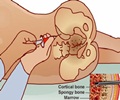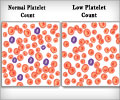
CAMT is caused by the congenital loss of thrombopoietin receptor-mediated intracellular signaling, resulting in a state of severe thrombocytopenia from birth and leading in the infant period to bone marrow failure and gradual depletion first of red blood cells and then of white blood cells. This grave illness requires bone marrow transplant for the patient to survive, but the lack of an adequate experimental model has hitherto been a hindrance to elucidating its pathology. In the present study, with the cooperation of one CAMT patient who has now received a bone marrow transplant and recovered, iPS cells (CAMT iPS cells) were generated and induced in vitro to differentiate into blood cells, whose behavior was analyzed in detail.
In the CAMT iPS cells, as in the CAMT patient's original blood cells, the thrombopoietin receptors were not functional. To check their ability to differentiate into megakaryocytes, platelets, erythrocytes (red blood cells), and other cell types, these iPS cells were differentiated into multipotent hematopoietic progenitors, which can in turn differentiate into a range of different blood cell types. It was found that the multipotent hematopoietic progenitors derived from the CAMT iPS cells, unlike the iPS cells from healthy subjects, had impaired ability to develop not only into megakaryocytes and platelets, but also into erythrocytes. They did however retain some ability to differentiate into white blood cells. These characteristics closely reflect the pathological state seen in CAMT patients.
Source-Eurekalert











